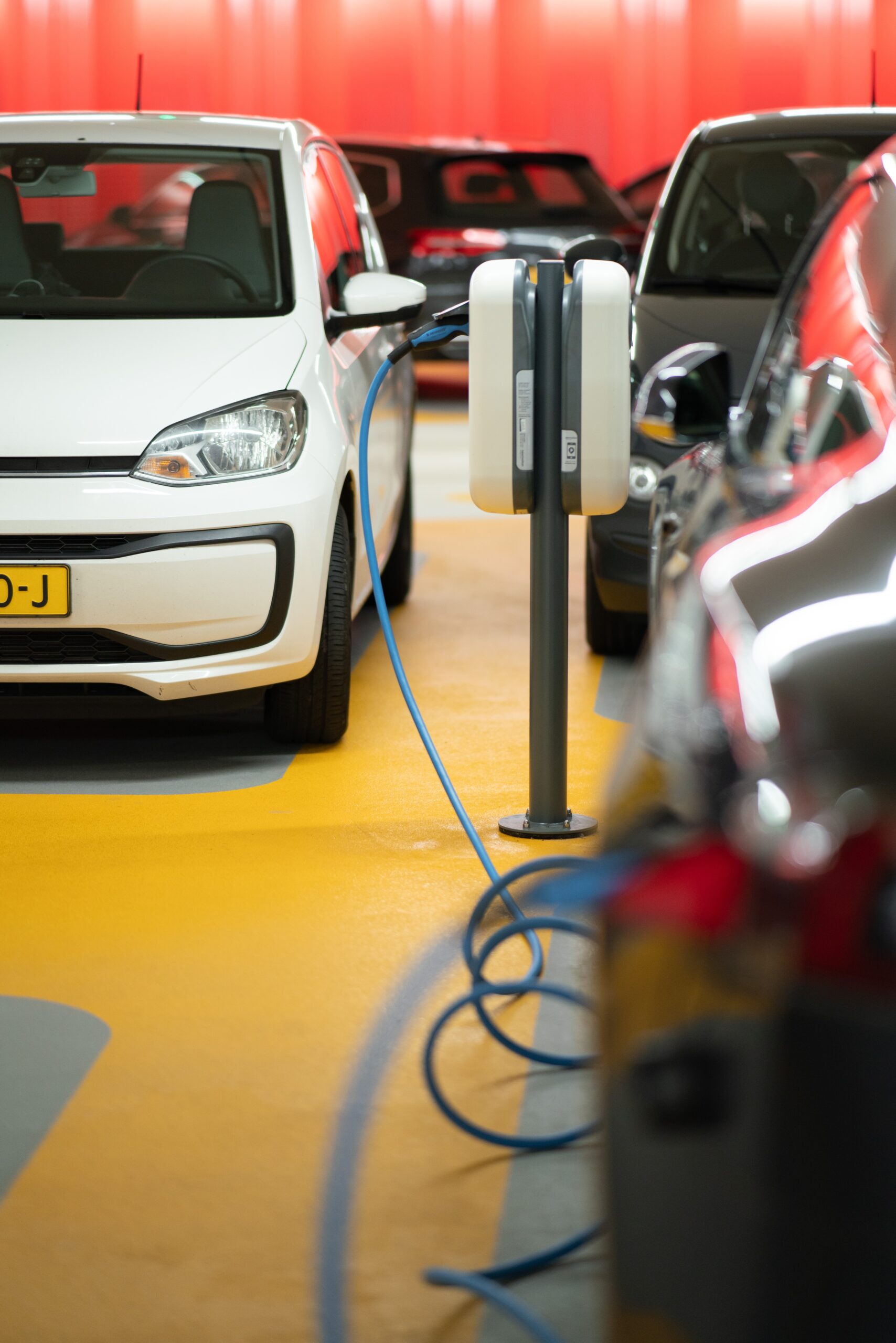Who’s in charge of EV chargers—and other power grid additions?
by Katie Singer
Years ago, I heard the engineering principle that no technology is safe until proven safe. To prove safety, professional engineers (PEs) evaluate a proposed technology with due diligence: they study all questions—including ones from non-engineers like me. PEs carry liability for their reports about infrastructures like substations, water treatment facilities, buildings and bridges. After comprehensive due diligence, they certify that a technology’s hazards have been mitigated—or not.
Our techno-society’s safety and functioning depend on engineering due diligence.
In The EV Transition Explained (published by the Institute of Electrical and Electronics Engineers), Robert Charette reports that charging an electrical vehicle (EV) can overheat a transformer—and shorten its typically 30-to-40-year lifespan to three years. (Transformers reduce electricity’s voltage when it’s transmitted from a substation to a residence or business; above-ground transformers look like trash cans mounted on utility poles.) When I shared Charette’s report with an LA friend, he told me that the underground transformer 50 feet from his house exploded last April on a Saturday morning—a time he considered low-demand for electricity.
“Is it low-demand,” I wondered, “if a handful of neighbors charge their vehicles Friday night?”
“Our current grid,” BigBattery.com’s Eric Lundgren told me, “was not designed to have ten EVs chargers and ten air conditioners turn on at same time on one city block. It’s not designed to charge EV batteries on fast chargers.”
A few days after I talked with Eric, seven automakers announced they’ll collaborate to deploy 30,000 fast chargers around North America. These machines can recharge a drained EV in 30 minutes or less—while owners eat lunch or shop.
Who’s in charge of these chargers?
Grid safety
The electricity consumed by a business, household, appliance or electronic device is called power. Power is measured in kilowatt hours (kWh): the rate of flow times the amount of electricity consumed per hour.
A PE who evaluates substations before they go live explained to me that to deliver power safely, a utility determines the maximum kWh that a household requires; then, it provides correctly-sized wires and transformers. Designers always factor for future growth. Still, when an older house—let alone a dozen on one block—adds a major electrical load like an EV charger, the grid’s capacity probably needs to increase. The utility should recalculate the size of wires and transformers needed to manage and transmit power.
“Do they do this?” I asked.
“Probably not,” he said.
An increasingly complex grid
This PE added that rooftop solar systems contribute to the grid’s complexity. “Rooftop solar,” he explained, “moves power from the customer back to the transformer, back to the grid.”
The grid’s distribution system was not designed for this.
“Then,” he continued, “because solar power is a customer-controlled energy source, the utility no longer controls its power supply. Before homeowners covered their rooftops with solar panels, utilities should have studied how to make non-firm energy benefit firm energy. They should have studied the utility’s production pattern against the production pattern of customer-owned systems. They should have calculated the utility’s hourly cost of voltage control service, not just the cost of fuel.”
But they did not.
There’s more: Rooftop solar systems generate power mostly from 11am to 3pm on sunny days. But the greatest demand for power starts around 5pm, when people arrive home, turn on air conditioners, TVs, stoves—and EV chargers.
Peak demand for electricity and solar power generation do not match up. Since they provide intermittent power, solar (and wind) systems depend on fossil fuels or batteries for backup.
Yet other problems
I understand that manufacturing, operating and discarding gas-powered internal combustion engine (ICE) vehicles ravage ecosystems.
But EVs are not clean, sustainable or zero-emitting, either. Not if we look past their tailpipes.
EVs depend on mining many more ores than ICE vehicles require. Mining and smelting ravage wildlife habitats, waterways, air and indigenous communities.
To make cars sold in the U.S. profitable, their raw materials (copper, lithium, quartz, tin, etcetera) must come from the U.S. (Therefore, expect increased mining in the U.S.—like at Thacker Pass, Nevada—not just in other countries and the deep sea.)
Gerry McGovern (author of Top Tasks, researcher of online meetings’ ecological impacts) reports that Ireland has turned its rural land into a green sacrifice zone and become one of the most mining-and-waste-friendly countries in the world.
Garbage
Different batteries have different constructs and chemistry. Tesla batteries are held together by “an almost indestructible polyurethane cement.” Nissan’s Leaf battery can take two hours to dismantle. Recycling batteries can release toxins and pose fire hazards. By 2035, we’ll have 150 million unusable, toxic EV batteries. If you own an EV, what will you do with your used battery—and its tires, computers and body?
Eric Lundgren considers recycling a last resort. “Still,” he thinks, “we should put old EV batteries in salt water, shred them to a black mass, extract the tin, cobalt, copper, manganese—and make new batteries.” While we don’t yet have enough waste to make this economically viable, soon enough, we will.
Increasing geopolitical conflicts
The International Energy Agency expects demand for lithium to grow 40-fold by 2030. Graphite, cobalt and nickel mining will grow 20-25 times. In mineral-rich Afghanistan, the eightfold rise in lithium’s market price around the time of the Taliban’s 2021 takeover has enticed Chinese mining entrepreneurs to partner with Taliban leaders.
For now, China makes about 79% of all lithium batteries.
EV batteries pose fire hazards
Because of their fire hazards, some companies will not ship EVs.
Firefighters typically extinguish a gas-powered vehicle fire with 300 gallons (113 liters) of water. One fire truck holds 500 gallons (1893 liters). Extinguishing an EV fire uses 20,000 – 30,000 gallons (76,000 – 113,562 liters) of water. Tesla advises firefighters to watch it for 24 hours, since, like trick candles, EV batteries can re-ignite.
After several General Motors’ Bolts caught fire in 2021, GM told EV owners to park vehicles outdoors immediately after charging and not to charge them overnight.
Electric bikes’ exploding batteries also cause deadly fires.
What we need now
An engineer once told me that since most energy is guzzled and most waste is emitted during manufacturing, keeping an old, gas-guzzling car in good repair harms ecosystems much less than buying a new one.
Meanwhile, at least two of my neighbors (who believed that EVs help, ecologically) have their own chargers. Who evaluated and monitors these chargers? To prevent our neighborhood’s transformers from dying quickly and/or exploding, should EV owners hire a PE to coordinate charging times? Should owners and non-owners confer with the utility about upgrading wiring and transformers? Who will pay for the upgrades?
Most of all, we need humility—to admit that we’ve assumed technologies’ safety and sustainability—and willingness to learn realistic, safer-making, Earth-respecting steps.
KATIE SINGER writes about technology’s impacts on nature. She believes that if she’s not aware of the problem, then she can’t be part of the solution. She dreams that every user learns about the supply chain of one substance in their computer. Her books include An Electronic Silent Spring, Honoring Our Cycles and The Wholeness of a Broken Heart. Visit https://katiesinger.substack.com, https://OurWeb.tech and https://ElectronicSilentSpring.com.


